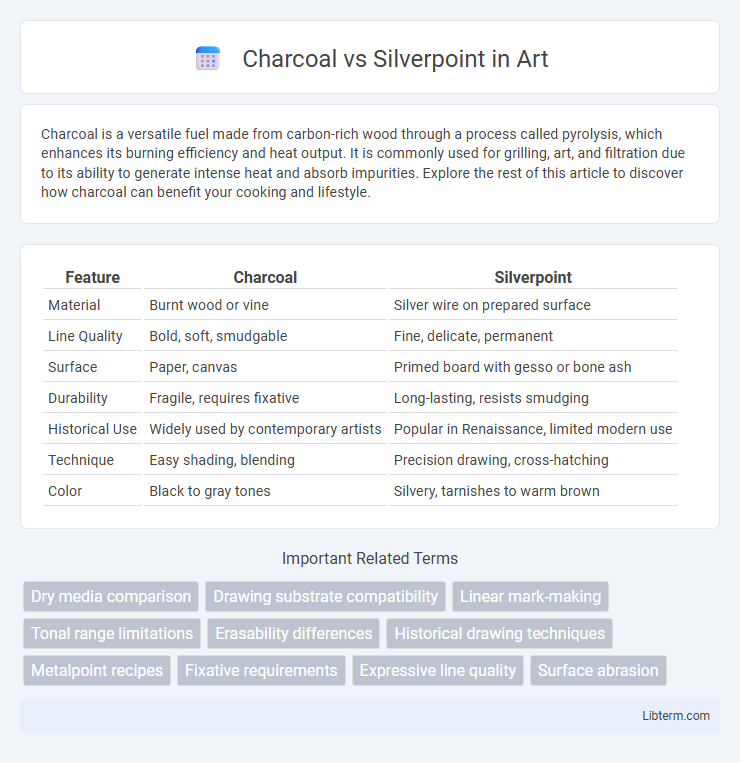Charcoal is a versatile fuel made from carbon-rich wood through a process called pyrolysis, which enhances its burning efficiency and heat output. It is commonly used for grilling, art, and filtration due to its ability to generate intense heat and absorb impurities. Explore the rest of this article to discover how charcoal can benefit your cooking and lifestyle.
Table of Comparison
| Feature | Charcoal | Silverpoint |
|---|---|---|
| Material | Burnt wood or vine | Silver wire on prepared surface |
| Line Quality | Bold, soft, smudgable | Fine, delicate, permanent |
| Surface | Paper, canvas | Primed board with gesso or bone ash |
| Durability | Fragile, requires fixative | Long-lasting, resists smudging |
| Historical Use | Widely used by contemporary artists | Popular in Renaissance, limited modern use |
| Technique | Easy shading, blending | Precision drawing, cross-hatching |
| Color | Black to gray tones | Silvery, tarnishes to warm brown |
Introduction to Charcoal and Silverpoint
Charcoal is a versatile drawing medium derived from charred wood, known for its rich, deep blacks and ease of blending, making it ideal for expressive, bold sketches and shading techniques. Silverpoint, a traditional drawing method using a silver wire stylus on prepared paper, produces delicate, fine lines that develop a warm, tarnished patina over time, prized for its precision and subtle tonal variations. Both mediums have distinct historical significance and aesthetic qualities, with charcoal offering immediacy and dynamism, while silverpoint provides permanence and refined detail.
Historical Background of Each Medium
Charcoal dates back to prehistoric times, valued for its ease of use and rich, deep blacks in cave paintings and early sketches, making it a foundational medium in art history. Silverpoint emerged during the Renaissance, prized by artists like Leonardo da Vinci for its fine, delicate lines created by silver rods on specially prepared surfaces. Both mediums reflect distinct historical contexts: charcoal with its primal, bold application and silverpoint with its precision and permanence, marking significant evolutionary steps in artistic techniques.
Materials and Tools Required
Charcoal drawing requires compressed or vine charcoal sticks, charred wood pencils, kneaded erasers, blending stumps, and textured paper like newsprint or rough sketch paper to hold the pigment. Silverpoint involves a fine silver wire stylus or pen used on specially prepared surfaces coated with gesso or a ground containing bone ash, chalk, or other absorbent materials to capture the metallic marks. Both techniques demand careful material selection to achieve desired texture, tone, and permanence in the artwork.
Techniques Unique to Charcoal Drawing
Charcoal drawing utilizes compressed or vine charcoal sticks that enable rich, deep blacks and smooth tonal gradations unique to its medium, allowing for expressive shading and blending techniques not achievable with silverpoint. Its ability to be easily smudged and erased provides artists with dynamic control over texture and value transitions, facilitating atmospheric effects and soft edges. Unlike silverpoint's fine, precise lines produced by a silver stylus on prepared surfaces, charcoal offers a broader range of marks, including bold strokes and subtle gradients essential for gestural and expressive artwork.
Silverpoint Drawing Methods and Practices
Silverpoint drawing methods involve the use of a silver stylus on specially prepared surfaces, typically coated with a ground containing bone ash, chalk, or pigment, which allows the metal to leave faint but permanent marks. Artists meticulously apply delicate, fine lines with controlled pressure to build tonal variation and intricate textures, emphasizing precision and subtlety over broad strokes. This traditional practice demands patience and skill, as corrections are difficult and the drawing gradually oxidizes, developing a warm patina unique to silverpoint artworks.
Visual Effects: Texture and Tonal Range
Charcoal offers a rich, velvety texture with deep, intense blacks and a broad tonal range from soft grays to stark shadows, allowing for expressive shading and dramatic contrasts. Silverpoint, in contrast, produces fine, delicate lines with a limited tonal range, delivering subtle, muted grays and a smooth, almost ethereal texture that highlights intricate detail over bold shading. Artists often choose charcoal for dynamic, textured compositions, while silverpoint excels in refined, precise drawings with a timeless, luminous quality.
Longevity and Preservation Concerns
Charcoal artworks often face challenges in longevity due to their powdery nature, making them susceptible to smudging and degradation without proper fixatives and protective framing. Silverpoint drawings, composed of fine silver lines on prepared surfaces, are known for exceptional durability and stability, resisting fading and maintaining sharpness over centuries. Preservation concerns for charcoal emphasize careful handling, controlled humidity, and UV-protected environments, whereas silverpoint requires minimal intervention, making it highly favored for long-term archival integrity.
Suitability for Different Artistic Styles
Charcoal excels in expressive, bold strokes ideal for gestural drawing, figure studies, and dynamic shading techniques, making it suitable for artists who prioritize immediacy and textural variety. Silverpoint demands precision and fine detail, thriving in delicate line work and renaissance-style drawings where subtle tonal gradations create intricate images. The choice between charcoal and silverpoint hinges on whether an artist seeks the expressive freedom of charcoal or the refined control and permanence of silverpoint.
Contemporary Artists Using Each Medium
Contemporary artists using charcoal, such as Julie Mehretu and Vija Celmins, exploit its rich, velvety texture and deep blacks to create dynamic, expressive works ranging from detailed portraits to abstract landscapes. Silverpoint, embraced by artists like Mark Golden and Sylvia Fein, appeals for its delicate lines and archival quality, allowing for intricate, luminous drawings with a historic feel. Both mediums offer distinct tactile qualities and artistic possibilities, enabling contemporary creators to explore texture, tone, and detail in unique ways.
Choosing Between Charcoal and Silverpoint
Choosing between charcoal and silverpoint depends on the desired artistic effect and technique. Charcoal offers rich, deep blacks and greater flexibility for blending and shading, making it ideal for expressive, bold drawings. Silverpoint requires a prepared surface and produces delicate, fine lines with subtle tonal variations, best suited for detailed, precise work and archival longevity.
Charcoal Infographic

 libterm.com
libterm.com